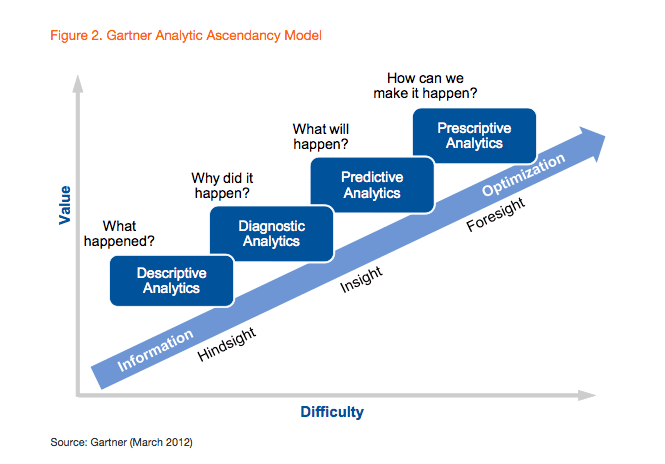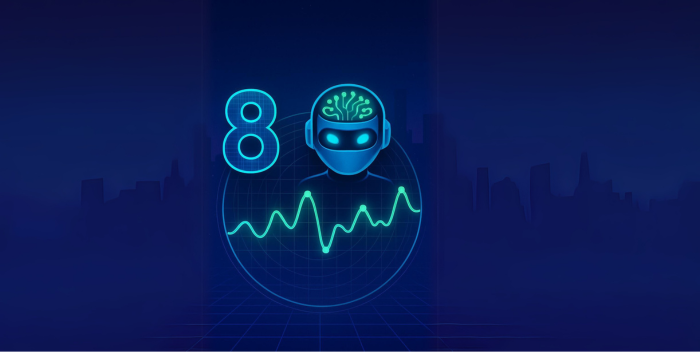In this article:
- What is AI Analytics?
- Business Analytics and AI
- What is Analytics?
- What are AI, Machine Learning and AI Analytics?
- What’s the Difference Between AI Analytics and Traditional Analytics?
- Business Use Cases for AI Analytics
- Summary: AI Provides Competitive Advantage To Modern Analytics Stack
What is AI Analytics?
AI analytics uses machine learning algorithms to constantly monitor and analyze huge amounts of data, automating the time-consuming work normally done by a data analyst.
Business Analytics and AI
If you’ve been following the technological developments of AI over the past few years, you know that it’s having an impact on nearly every industry.
Business analytics is no different.
Once driven by centuries-old statistical modeling techniques, AI and machine learning are now transforming the field of analytics by offering a level of speed, scale and granularity that’s humanly impossible.
This article will briefly answer the following, in the context of business:
- What is Analytics?
- What is AI Analytics?
- What’s the Difference Between AI & Traditional Analytics?
- Real World Applications of AI Analytics
What is Analytics?
Analytics refers to the process of identifying, interpreting and communicating meaningful patterns of data. Business analytics refers to applying this process to answer business questions, make predictions, discover new relationships and ultimately make better decisions.
In essence, analytics is the process of taking raw data and applying some form of analytical technique in order to find meaningful patterns in the data. The analytical techniques that we can use vary, although a few of the most popular methods include:
- Applied mathematics
- Statistical analysis
- AI & Machine learning
The field of analytics can be further broken down into several stages as highlighted in the Gartner Analytic Ascendancy model:
As you can see from the image above, the Gartner Analytic Ascendancy model is divided into four stages of increasing difficulty and value, these include:
- Descriptive analytics: The first stage of analytics is hindsight-based and asks the analyst to determine what has already happened in the data.
- Diagnostic analytics: The next stage is more insight-driven and asks the analyst to identify why a particular event or change in the data occurred.
- Predictive analytics: As we move past insights, the next step in analytics is based on foresight and determining what will happen next.
- Prescriptive analytics: Finally, often the most difficult and valuable stage in analytics is determining how exactly we can make the desired outcome become a reality.
Now that we have an idea of what analytics is and how it can help answer business questions, let’s discuss what AI analytics is.
What are AI, Machine Learning and AI Analytics?
As mentioned above, AI and machine learning are the most recent modeling techniques that have been applied to the field of analytics. Before we get into the use cases of AI analytics, let’s first review what each of these terms means.
Artificial Intelligence
AI is a broad field of computer science that refers to any sort of intelligence demonstrated by machines. Often, this term refers to machines mimicking cognitive functions such as learning, problem solving, reasoning and representation. AI can be applied to everything from understanding human speech, self-driving cars, playing games, and of course analytics. Several approaches to solving problems with AI include statistical techniques, search optimization and artificial neural networks.
Machine Learning
Machine learning is a subset of artificial intelligence that combines algorithms, statistical models, and data in order to perform a specific task, without being explicitly programmed. A key part of machine learning is that instead of providing explicit instructions for how to perform a task, the models rely on patterns and inference instead. In particular, in order to perform machine learning this involves creating a model that is trained using training data and then can be fed new data in order to make predictions.
AI Analytics
AI analytics refers to a subset of business intelligence that uses machine learning techniques to discover insights, find new patterns and discover relationships in the data. In practice, AI analytics is the process of automating much of the work that a data analyst would normally perform. While the goal is certainly not to replace analysts, AI analytics often improves a data analyst’s capabilities in terms of speed, the scale of data that can analyzed and the granularity of the data that can be monitored.
Augmented analytics is yet another class of analytics that Gartner says will be the future of analytics. Augmented analytics uses artificial intelligence and machine learning to look for patterns in data or discover valuable insights without the involvement of data scientists.
What’s the Difference Between AI Analytics and Traditional Analytics?
To better understand the field of AI analytics, let’s now review its differences between traditional data analytics.
Traditional data analytics is generally undertaken by a technical team of data analysts. Here’s an example of how a team of analysts might traditionally attempt to solve a business challenge:
- An event, incident or trend occurs in the company over a period of time – for example, sales are down for the quarter.
- Data analysts then form hypotheses about what the potential causes might be for the sales decrease.
- These hypotheses are then tested against the data for that time period until they find enough evidence to support a particular hypothesis.
- The analysts then write a report that summarizes their findings and will often present potential next steps for the business to take.
As you can imagine, this whole process from the initial change to determining the underlying causes is extremely time consuming. Not only that, but there’s also no guarantee that the answers the data analysts find are the right ones due to their inherent limitations.
Once driven by centuries-old statistical modeling techniques, AI and machine learning are now transforming the field of analytics by offering a level of speed, scale and granularity that’s humanly impossible.
AI analytics, on the other hand, based on machine learning algorithms constantly monitors and analyzes huge amounts of data. The results stand apart from traditional analytics in:
- Scale
An AI-based anomaly detection solution learns the normal behavior of the data without being explicitly told what to look for. It does it at any granularity: revenues per country, products, channels, etc.
- Speed
The AI model will identify unusual drops in revenue and alert the appropriate teams in real-time. In addition, an AI-based analytics solution leverages clustering and correlation algorithms to provide a root-cause analysis so that any issues can be remediated as soon as possible. This reduces remediation time by orders of magnitude, since the analysis is done constantly, and in real time, instead of the quarterly, monthly or weekly at best, as done with the traditional analytics. AI-based anomaly detection also finds anomalies faster. Our 2023 Cloud Cost Report shows, that 84% of Anodot’s clients detect anomalies within hours – that’s faster than the market average.
- Accuracy
AI Analytics is based on ML algorithms that are able to learn many different patterns of normal behavior very accurately, and provide correlations between anomalies in a way that is nearly impossible for an analyst to perform (correlations between millions of time series in some cases). Of course, the accuracy of the ML algorithms depends on how they were designed – they need to autonomously learn many different patterns accurately – which requires the use of multiple types of algorithms. For more details on these requirements, see our 3-part white paper.
Also, unlike data analysts, these algorithms don’t have any bias towards the business questions at hand. For example, instead of having pre-existing assumptions about the likely causes of a change in revenue, AI analytics can analyze large quantities of data and provide a completely objective analysis of the situation. This means that AI analytics can test infinitely more hypotheses than traditional analytics — often in seconds instead of weeks.
Business Use Cases for AI Analytics
Now that we’ve reviewed what AI analytics is and how it compares to traditional data analytics, let’s review several use cases of AI analytics that nearly all businesses can benefit from:
- Forecasting Demand: This is an example of predictive analytics and is one of the most powerful applications of AI. In fact, according to McKinsey Digital, AI-powered forecasting can reduce errors in supply chain networks by 30 to 50%.
- Predictive Maintenance: This refers to AI-based techniques that are designed to predict the condition of a company’s equipment so that they can estimate when maintenance will need to be performed.
- Business Monitoring: From customer experience monitoring to revenue and cost monitoring, this is an example of diagnostic analytics that nearly every company can make use of to improve customer satisfaction, reduce churn and increase revenue.
Now let’s look at a few more specific real-world applications of AI analytics.
eCommerce Analytics
An example of a diagnostic analytics problem from the Gartner Analytic Ascendancy model is answering the question: what’s causing conversion rates to change?
Since there are so many data points that could be influencing changes in conversion rate, this is a perfect application for AI analytics in eCommerce. In addition, since this is an on-going challenge to solve for eCommerce companies, having a solution that is constantly analyzing data means that you can detect issues early on. This can end up saving a significant amount of potentially lost revenue for the company. In particular, an AI-based solution can learn the nuances of your conversion rate and autonomously detect changes and create real-time forecasts.
Fintech Analytics
An example of prescriptive analytics in fintech is detecting and preventing potential security issues. AI analytics can be used to close security loopholes by monitoring the behavior of operational metrics so that you can be proactive about your security. By centralizing all data sources into a single platform, machine learning can be used to understand how these metrics behave normally, detect anomalies and prevent issues in real-time.
Telco Analytics
An example of AI analytics in the telecommunications industry is answering questions such as: “is the network stable?” and “are customers having issues with roaming services?”
Both of these questions can be answered using AI by automatically identifying changes in service quality, which can also reduce churn and increase ARPU. In particular, an AI solution like Anodot can use its Root Cause Analysis and its correlation engine to reduce time to remediation for potential issues in the network.
Cloud Cost Analytics
AI analytics allows to gain full visibility into organization’s cloud costs, which is difficult to do without the help of the algorithm due to the ever-changing nature of the cloud ecosystem. That is becoming increasingly important, as organizations report leaning more and more towards establishing multi-cloud environments, as our 2023 State of the Cloud Report suggests.
AI also helps correlate cloud expenses with business KPIs and provide tailored recommendations for cost optimization.
Summary: AI Provides Competitive Advantage To Modern Analytics Stack
As we’ve discussed, the application of AI to business analytics offers capabilities that traditional data analysts simply cannot achieve in terms of speed, scale and granularity.
Traditional analytics often involves a high degree of manual labor for things like coming up with hypotheses, data pre-processing, visualization and applying statistical techniques.
The issue with this approach, however, is that the time it takes to perform these tasks manually is far too long for today’s fast-paced business landscape.
To solve this, many companies are embracing AI analytics for everything from demand forecasting, anomaly detection and business monitoring. In particular, machine learning algorithms can be used to augment your technical teams capabilities so that they can respond to business changes as soon as they occur.






